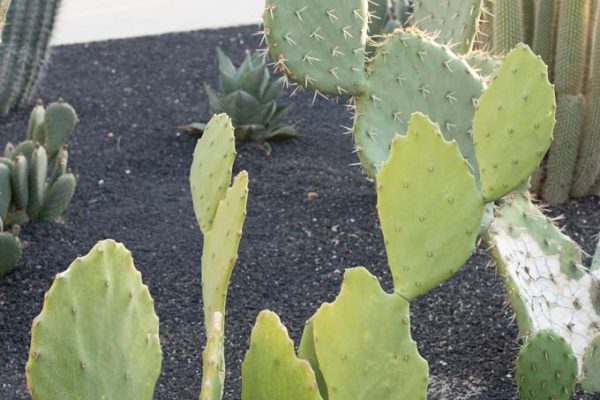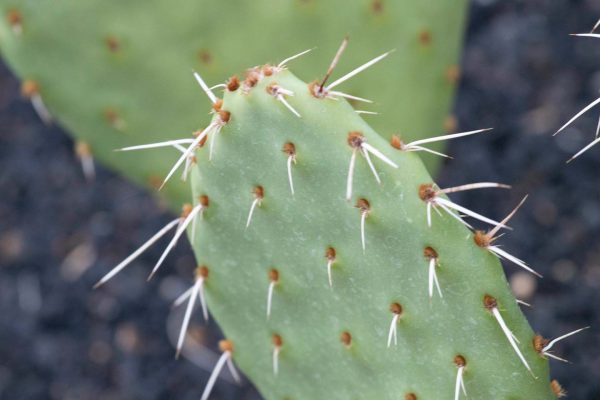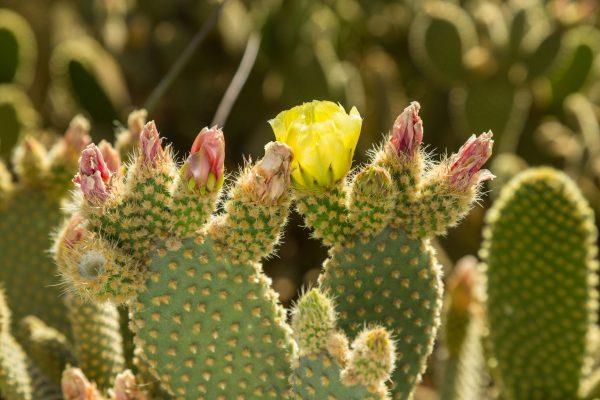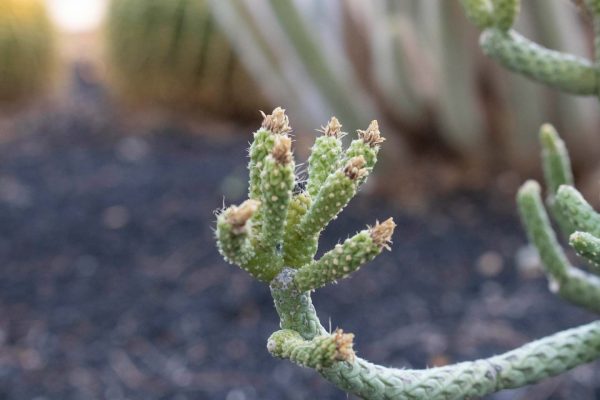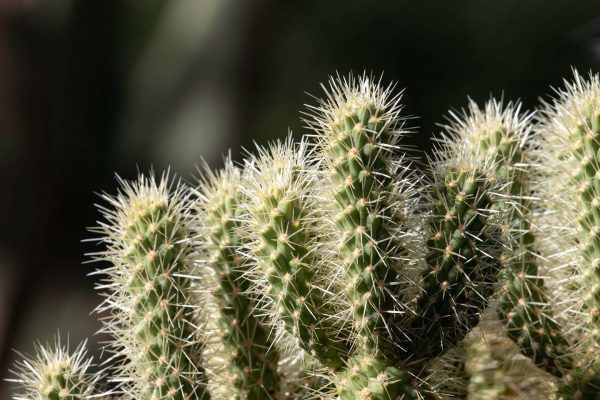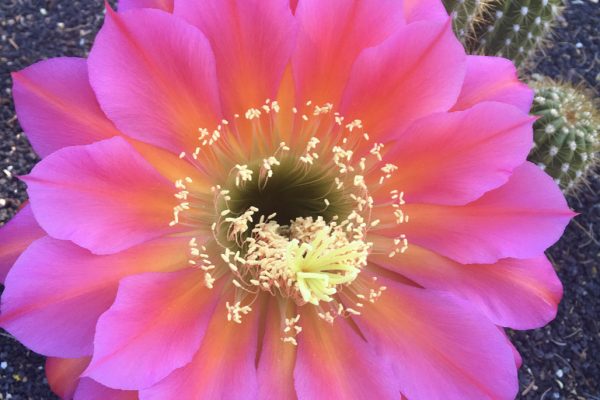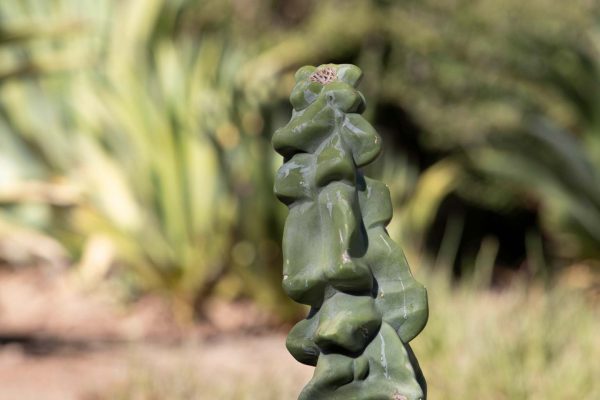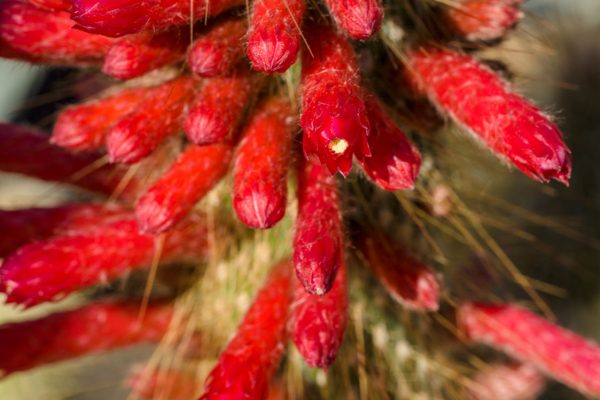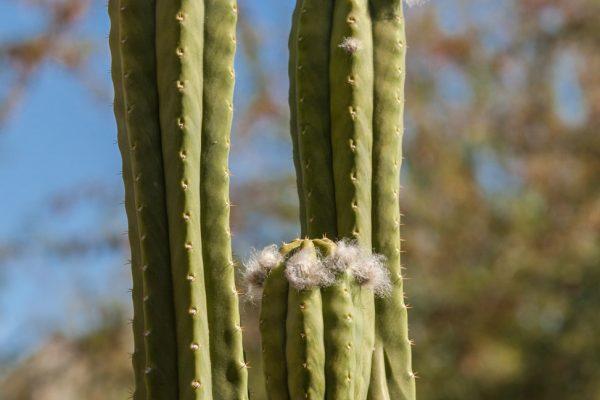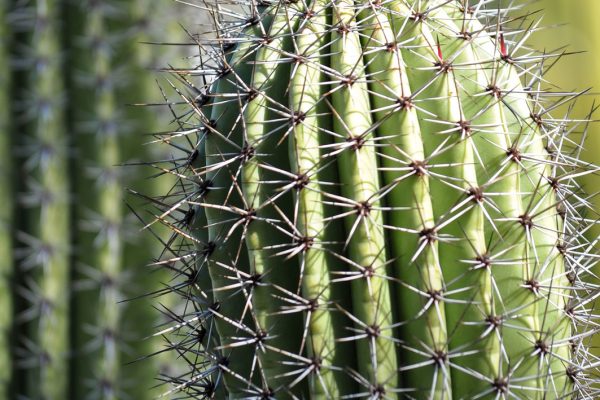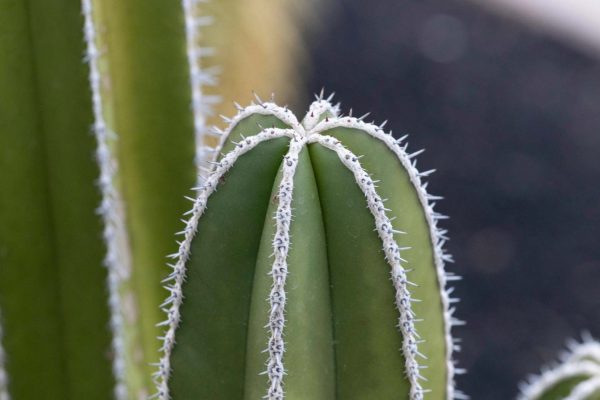Old Mexico is one of the Opuntia in the specimen beds between the café and solar field. It has bright green pads (stems) with vivid yellow spines (leaves) and it makes a wonderful accent plant in gardens. The spines will stand straight and may be accompanied by glochids, which are small barbed spines that appear like fur. The plant needs plenty of room to grow as it branches wide, sprouting new pads to create a large shrub appearance.
Old Mexico is sometimes classified as lindheimeri (Britton and Rose) and has some of its characteristics, but it is distinct on its own, and intermediates have not been identified.
Blooms are bright yellow and funnel-shaped. Fruit is dark purple, and like other Opuntias, this plant is a food plant.
It is common near the Rio Grande delta and some inland areas of southern Texas.
This is one of several Opuntia in the specimen beds between the café and solar field. A sprawling, shrubby Opuntia, it will grow in many directions. It doesn’t usually form stems, instead pads spread from the base. Its pads can grow up to a foot long, and its spines (leaves) can be quite variable and, on some plants, completely absent. It has hybridized into many varieties that occur in different regions as a result of human selection, use, and its tendency to replant easily in disturbed areas.
Its bloom is yellow to reddish in color, and many parts of the plant are used for food and medicine.
Its distribution is widely spread through Arizona, New Mexico, Texas, Oklahoma, and Louisiana, and in San Luis Potosí, Tamaulipas, and Hidalgo, in northern and central Mexico.

Bunny Ear is found along the path that surrounds the wildflower field and in the specimen beds between the café and solar field. It is a beautiful example of the Opuntia genus, displaying small pads with spines placed close together that give it a fuzzy appearance.
With a common name that evokes a soft and cuddly image, Bunny Ear is a very misleading cactus. The fuzzy hairs on its pads are not soft and touchable. They are groups of spines known as glochids, which are small but strong in bite if you mistakenly brush against them. They are delicate and break off easily at the skin’s surface, but their barbed spines, left embedded in the skin, are very difficult to retrieve. The pain from the almost invisible embedded spines can last for days, sending a stinging sensation each time that part of the skin is touched.
REMOVAL OF GLOCHIDS: If you accidentally touch this cactus, do not attempt to wipe off the glochids, as they can attach to other parts of your skin, causing additional wounds. The best removal strategy is duct tape. Though it may not get all the spines, it is an effective remedy for most. Tweezers and a magnifying glass are good tools to remove the rest.
Bunny Ear blooms in the warmer months. Soft yellow cup-shaped blooms will appear, which are a delight to many pollinators. North and South American desert plants have a unique pollination strategy with native bees. Rather than using leg pouches like honeybees, solitary bees roll around in the flower cups, covering themselves in pollen to be distributed at their next stop. Catching them in the act is a delight, reminiscent of a dog rolling in grass.
Native and endemic to northern and central Mexico.
The Walking Stick or Cane Cholla is a compact tree-like cholla that produces unique looking whorled branches. In water, it follows the pattern of some other cholla species and turns a flush of purple. It has the ability to form hybrids with other chollas, including Teddy Bear or Jumping Cholla, which is also planted in the specimen bed.
It blooms red to purple, yellow, or white blossoms, followed by spineless fruit that are yellow tinged with purple and will remain on the cactus until the following spring.
Its origins are the desert and grasslands of Arizona and New Mexico in the United States and the states of Sonora and Chihuahua in Mexico. It prefers high elevations well over 6,000 feet, due to a strong frost tolerance.

Teddy Bear Cholla is in the specimen beds between the café and the solar field. The nickname Teddy Bear comes from its appearance as a fuzzy plant, but the “fuzzy” is actually densely placed blond spines. Also referred to as Jumping Cholla, this skilled desert propagator uses a clever method to expand its territory. Barbs at the end of each spine allow the Cholla to grab on to anything passing with the slightest brush against it. It readily detaches from the main plant to hitch a ride on fur, t-shirts, or human skin. The touch need only be slight. Often the victim doesn’t realize a transfer has occurred. It’s easy to assume the spined balls jumped off the main plant or up from the ground where they blow around until settling to root in sandy or rocky terrain. Cactus Wrens and even Mourning Doves recognize the benefits of nesting in Cholla where predators risk serious injury if they pursue them. Small desert woodrats go a step further, using them to build a fortress around their burrow entrances.
The blooms are cup-shaped and range from a green to yellow color. They are sometimes tipped in tones of red.
Cholla’s range extends from the Mojave Desert in California, Nevada, and Arizona, down into Baja California and the Sonoran deserts of northern Mexico. It prefers to be below 3,000 feet in elevation, in sandy and rocky washes, and in bajadas (base of alluvial fans).
This smaller columnar cactus is in the specimen beds between the café and solar field and will grow to about 3 feet. It is a very attractive columnar cactus—perfect for small gardens or several planted in a larger space.
The varietal name grandiflora is no joke! It produces huge blooms and, with a variety of hybrids on the market, it is available in many colors, including pink, red, yellow, and bright fuchsia. When in bloom, they stop visitors in their tracks.
Previously named Lobivia grandiflora or Trichocereus grandiflorus.
Torch originates in Catamarca, Argentina.

Totem Pole is in the specimen beds between the café and the solar field. This columnar cactus is hard to miss with its protruding branches that resemble large bumps along its column. It is a slow growing, small cactus, with smooth spineless skin. It will grow branching stems low to the ground. Most visitors to Sunnylands are familiar with columnar and barrel cactus highlighted in old western movies, but have less exposure to the more unusual varieties. This unique specimen is a delightful departure from standard garden cactus and often is a point of conversation on garden walks.
Totem Pole is a night bloomer. The genus Pachycereus is Greek and Latin for “thick,” “candle,” “wax,” and “torch,” likely referencing their night-blooming nature. Many white-flowering desert plants provide nectar to migrating bats or moths, and so they bloom open at night and then close by the following midday. The flowers will be followed by the formation of sweet red fruit, with seeds called pitaya.
Its origins are in South America, including Brazil, Argentina, and Peru.
The best place to identify this species is in the specimen beds near the shuttle gate, though there is one in the specimen beds by the café. This cactus has a hefty stem diameter and a heavy covering of hair-like spines, which is where the common name Old Lady originated. Edward F. Anderson’s 2004 edition of The Cactus Family does not give this species a common name, but it is referenced elsewhere as Old Lady.
The Espostoa genus has not been studied extensively and many species will likely be reclassified through future phylogenics (gene study).
Greenish-white to red colored fruit will follow white bell-shaped flowers.
Distribution is northern to central Peru.

The specimen beds near the café have several Silver Torch cacti. The original planting included the species strausii, but clearly there are some other varieties from within the genus, and possible hybrids displaying a range of bloom color and spine distribution.
Silver Torch displays an abundance of spines on thin, cylindrical stems. It grows to about 10 feet. In the botanical genetics field, there is still some disagreement as to what should be included in the Cleistocactus genus, so as cactus are sorted more specifically along genetic lines rather than botanist observations, we will see new groupings in the future.
Red blooms can occur on Silver Torch Cactus throughout the year. At Sunnylands, the blooms emerge between red and orange, but generally the plant can flower with yellow and green blooms, too. The flowers barely open, and it is from this they get the name of the genus, Cleistocactus, as Kleisto in Greek means, “closed.” This tightly wrapped bloom may show some diversity, growing both straight and curved on different species. The blooms have a beak shape that closely accommodates the beaks of the hummingbirds that pollinate them. Birds with larger beaks would have difficulty. Flower design clearly shows preference when it comes to pollinators. In this case, it’s the hummingbirds that are preferred.
The genus of Cleistocactus extends throughout Argentina, Peru, and Bolivia.
San Pedro is planted throughout the gardens. You can see it in the specimen beds, in spotlight beds around the wildflower field, and the lower garden path. This is a columnar variety with very small spines spaced along the rib margins. In some cases, the spines are completely absent. Native at much higher elevations than Sunnylands, it nevertheless seems to thrive on the desert floor, as it is one of our most prolific bloomers.
The fragrant, white blooms open at night to await the nocturnal pollinators, bats, and moths.
The large, funnel-shaped blooms remain open the next morning, finding themselves the host of native bees who are completely engulfed by the long, pollen-covered stamens. The bees disappear into the bloom and re-emerge, speckled yellow.
San Pedro is native to Ecuador and Peru, where it is used extensively by indigenous cultures for medicine.

In the specimen beds between the café and the solar field, you will find the columnar Organ Pipe cactus. There are three in the bed closest to the café. Their flesh is dark green with red spines at the crown that turn gray down the column.
Another night-blooming giant, the Organ Pipe’s numerous branches can reach up to 26 feet. Its flowers are funnel-shaped and a pale cream color. The blooms open at night dispersing the scent of nectar that attracts moths and bats. Some come for the nectar and others for fruit—both exist simultaneously as the bloom period progresses. Insectivore species of Pallid Bat can be found hunting the pollinating moths foraging within the fruit. By late morning, the blooms close and the diurnal pollinators move in to take their turn as the day heats up and the fruits begin to ferment.
Distribution in Mexico includes Sonora, Baja California Sur, and Sinaloa. Arizona hosts the only wild range of this cactus in the United States, where it is designated as a national monument and UNESCO biosphere reserve.
This columnar cactus is in the specimen beds nearest the shuttle gate. It is easy to identify with the solid white margin along ribs that display its spines.
Like the Cardon cactus, Fencepost is part of the Pachycereus genus. The common name of Fencepost references its cultivation to create living fences. With a maximum height around 16 feet, it does make a formidable barrier when placed close together.
Mature specimens bloom red, funnel-shaped flowers with pink interiors in rows down the rib margins.
Fencepost’s distribution is in Mexico, and includes the states of Hidalgo, Guanajuato, Querétaro, Morelos, Puebla, Oaxaca, Colima, Michoacán, and Guerrero.
